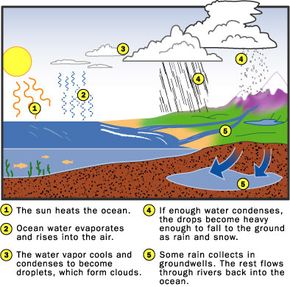The Cycle of Rain
Water plays a major role in weather, despite making up such a small fraction of the atmosphere. In some areas, the local atmosphere may contain as much as 4 percent water, while other regions have no atmospheric water at all. As water can exist as a solid, liquid or gas under normal atmospheric conditions, it participates in the hydrologic cycle. In this cycle, water evaporates from the ocean in the form of water vapor and eventually returns to land and sea in the form of precipitation.
You can't see water vapor, but it quickly becomes visible when it cools and condenses against something. If you've ever noticed moisture beads on the windows of a warm car on a cold day, you've seen condensation in action. Warm air vapor touches the cold window and the vapor turns back to a liquid. Clouds form along similar lines. The atmosphere is full of tiny dust particles called condensation nuclei, which come from volcanic eruptions, dust storms, fires and pollution. When water vapor condenses, it clings to these microscopic specks. If there's enough cooling water vapor in the air, these accumulate by the trillions to form clouds. If temperatures are cold enough, the water turns to ice around the condensation nuclei. For a more in-depth look at clouds, read How Clouds Work.
Advertisement
In a windless world, these water droplets would descend right back down to the surface, but Earth's complex upper air winds keep the clouds afloat, moving them across vast distances and altering their shape in the process. If too much water condenses around a particle or if the air temperature drops, the water will fall back to the surface. Liquid particles fall in the form of rain, while frozen particles fall as snow. If the rain freezes as it falls, it becomes freezing rain. In some cases, rain ascends to higher, chilly altitudes by an updraft; the particles freeze, then return to Earth in the form of a hailstone.
Clouds come in various shapes and sizes and occur at varying altitudes. They can even gather on the ground in the form of fog. This occurs when warm, moist air close to the ground either cools rapidly or becomes oversaturated with water vapor.
But as you know, Earth's most substantial cloud formations occur in the air. On the next page, we'll look at how all that water vapor gets up so high.
